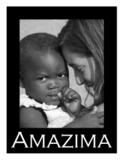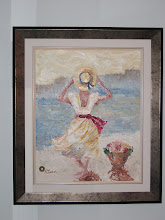You can get your 'colours' done professionally, but here are some simple tips to get started!
1. Make a list of the colours that instantly 'light up' your face when you put them (even when you are not wearing any make-up at all). Those colours are definitely colours that are 'good' for you; and you should have more of these colours in your closet. Colours that compliment your skin tone will make your complexion glow and make it appear clearer. Shadows under the eyes will become less pronounced.
2. Make a list of the colours that always get you compliments or those colours that friends tell you that you should wear more often.
3. Make a list of those colours that make you feel good when you are wearing them. When you feel good in something, you'll look great.
4. Keep in mind that it is the colour that is worn up near your face that matters most. So let's say you love khaki green, but khaki green really doesn't do that much for you - then wear khaki green in the lower torso (as a pant or skirt) and match it with a top that works well with your skin tone.
5. Finally a safe bet ~ navy blue and charcoal grey are colours that flatter just about everyone and are fabulous colour staples to have in your wardrobe.
Monochromatic Look
1. Any time you wear a single colour through the entire frame of your body you will look longer and leaner. (Great tip for those of us who wish to appear ~ ahem a little trimmer).
2. The colour you wear can be a light colour, a bright colour, a dark or dull colour - regardless of the colour you will get a lengthening effect through the body.
3. This illusion of length is created because you are providing the eye with a continuous line of colour without any colour breaks to stop the eye.
4. As a variation of the head to toe monochromatic look, you can also achieve this effect by wearing a pattern or a print head to toe, or by wearing subtle variations of the same colour.
5. To maintain the illusion of length but to add some interest to the outfit, add a contrasting coloured accessory or a contrasting patterned blouse to a matching blazer and skirt or pant.
Colour Breaks
1. When you are mixing two or more colours of different intensities, your eye will always be drawn to the lightest or brightest colour first versus the darker colour. Lighter colours appear to advance while darker colours appear to recede when they are mixed together.
2. Understanding this principle can help you make the most flattering colour combinations for your figure type.
3. For example, if you have a pear shaped body (fuller through the hip/thighs compared to shoulders) might want to try wearing darker colours in the lower torso (to de-emphasize this area) and brighter colours in the upper torso (to draw the eye upward and highlight this area).
4. Women who have an inverted triangle figure type (stronger shoulders in comparison to their hips) might want to try the reverse ~ darker colours in the upper torso and bright or lighter colours in the upper torso.
5. Also be aware that the eye will also focus on colour break points (the point where two colours meet), so be careful that your colour break points do not hit at your figure challenge area.
6. For example if you are wider through the hips or thighs be careful that the colour break point does not happen at your widest point. What you want to do is wear a jacket or top that ends either an inch or so above or below the widest point on your hips or thighs.
7. Use colour breakpoints to accent your figure assets as well. If you have a smaller waist line try wearing a top in a contrasting colour to your bottom piece and be sure to tuck it in. To further highlight your waist ~ wear a belt and do not wear a jacket to cover up that beautiful small waist.
Wearing Prints Or Patterns
1. When you mix prints with a solid colour ~ your eye will be drawn to the print or patterned piece first (as it is more visually interesting). For this reason a lot of women tend to avoid wearing prints or patterns on their lower torso.
2. If you want to wear a print on the lower torso, there is a way to soften the effect of the print or pattern. Make a list of all the colours in the print. Remember ~ the eye is drawn to lighter and brighter colours first, so select tops and jackets in the lightest or brightest colours in the print.
In the late 80's early 90's it was all the rage to "have your colours done". Although it is not as prevalent now as it was then, it is still a wise idea to match colours to your skin tone.
Skin tones were divided into Spring, Summer, Autumn and Winter. Once the season was established, you were then told the colours that would work best with your skin tones.
Hokey you may ask ~ no, I did succumb to having my colours done and there is a distinct difference in wearing a colour that work with your skin tone as opposed to wearing onees that do not.
Here is a breakdown of the four seasons ~
Summer
Summer is a cool tone and like winter complexions, the summers among us have blue or pink undertones. Skin is very pale and pink. Summer colouring usually occurs in natural blonds, and even pale-skinned brunettes with pale eyes. If you’re a trying to discriminate between winter and summer, winters are usually brunettes and summers are mostly natural blonds.
Summers have a low level of contrast between their hair, eye colour and skin tone. In order to look your best, choose soft neutrals and pastels, as well as muted colours with cool undertones.
Powder blue, dusty pink, mauve, lavender, plum, and pale yellow are all great colour choices.
The worst colours for summers to avoid are intense, vivid hues because they will look harsh. Don't wear earth tones either. Stay away from black and orange.
Autumn
Autumn is a warm tone and people with this complexion have golden undertones in their skin, like a pale peach, golden beige or golden brown. Many redheads and brunettes with golden brown eyes fall into this category. However, golden blond and black hair colouring can also fall into this range.
The best colours for Autumn are rich golden, spicy and earthy colours to accent your complexion. Therefore, look for a warm undertone when selecting a colour. You can wear both muted and rich warm colours that are seen in autumn leaves and spice colours, such as camel, beige, olive, orange, gold, and dark brown. You will also look great in a rich warm grey.
The worst colours for autumn to avoid are clear, bright colours and black and white, which will make your look tired and faded. Also steer clear of pastels and blue tones, which will look cold against your complexion and give you a pale appearance.
Winter
Winter is a cool tone. People with winter complexions have blue or pink or rosy undertones. Skin can be pale and porcelain white, yellowish-olive, or dark. Winters are generally brunettes with deeply coloured eyes. Many Asians and African Americans fall into this category. Natural white-blonds may also be winters.
The best colours for winters are colours that are sharp, stark and clear. You will look best in intense, rich colours, like black, navy blue, red, and hot pink. These powerful shades will compliment your colouring. For lighter colours, wear bright white or icy pastels, such as like cool blues, pinks and yellows.
The worst colours for winters to avoid are earthy tones and subdued colours like beige, orange and gold. They will make you look faded and ashen.
Spring
Spring is a warm tone. People of this complexion have subtle golden undertones and are usually creamy white or peach. Springs have extremely light, ivory skin colour. People of this colouring are usually natural golden blonds, auburn, or strawberry blond redheads. Springs also have very clear, light blue and green coloured eyes. Freckles and rosy cheeks are also characteristics of this group.
The best colours for springs are very pale, soft colours, such as peach, camel, golden yellow, golden brown, and aqua. You will also look fabulous in ivory, bright greens, true reds, clear blues and coral. Your colours may be particularly hard to find because they can never be too muted or too dark.
The worst colours for springs to avoid are black and white, which are too contrasting for you. Stay away from dark, dull colours.
The colour wheel is your best friend ~ buy one and keep it handy all the time. It really will help you are you work with colour placement in your home.
My living room has been monochromatic (shades of creams, custard, vanilla) for years, however this year I decided to inject a little colour into the room. I started by picking up a large bowl for my coffee table. It is clear with swirls of frosty white and a blue grey through it. Then I took the blue grey in the bowl and matched it to two cushions on the sofa in that same shade. Accessories on side tables in the same shade and then a large vase in a punchy tangerine (remember blue & orange are complementary colours) gave the living room a completely different appearance.
I have deliberately not posted any pictures in these last three posts on colour as I did not want to detract from the message on colour and how it affects our lives so strongly, however, if comments show interest I will post a picture of the living room before and after the colour injection so you can see the difference a little colour makes.
I apologize as well for the wordiness of these posts, but colour theory is a subject near and dear to my heart ~ a subject I had to study intently with my fine arts background and I pondered on the thought that my knowledge may be of some interest to some of you.
I hope you enjoyed the tips and tricks within these posts.
Well, Happy Weekend my friends, I hope these little primers on colour in your life will help you a little when you are adding more colour to your home ~ your wardrobe ~ your life.











1 comment:
Here is a fascinating book about colour and art and therapy and health as it all relates to each other:
http://www.steinerbooks.org/detail.html?id=0863153275
Post a Comment